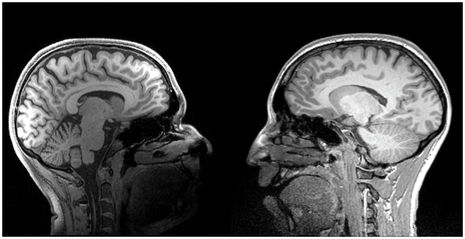Scientists must embrace the reality of neurodiversity
Our brains are far more varied than they think

Come July, the afternoons in Cambridge feel airless and sweltering. I’m perched on the stairwell of the MRC Cognition and Brain Sciences Unit, waiting for my next experimental participant to arrive. For the child whose name I have on my clipboard, it’ll be the summer holidays—a time to recuperate from the academic and social pressures of school. Unlike the expected challenges of the classroom, this will be an entirely new experience for my participant: today, they’ll get several MRI scans of their brain.
Every brain is different. Throughout development, our brains are shaped by a perpetual dance between our genes, embodied selves, and experiences. As a developmental cognitive neuroscientist, the aim of my research is to understand how the brain changes throughout childhood, and why this process of change differs so much between individuals. Specifically, I want to know more about behavioural, cognitive, and neurological diversity among children who are struggling at school.
Some people think that these forms of diversity can be cached out in terms of ‘neurotypes,’ which are said to correspond to various ways of sensing, thinking about, and interacting with the world. The idea that different neurotypes exist among humans finds its origins in the neurodiversity movement. This is a movement that aims to break down barriers to wellbeing among those who are said to be neurodivergent—people whose patterns of thinking and behaviour are different from the ‘norm.’
New ideas surrounding neurodiversity, neurodivergence, and neurotypes are also shaping the way we think about the brain. After all, what characterises a distinct neurotype? Does each neurotype correspond to a specific label—like Attention Deficit Hyperactivity Disorder, autism, or dyslexia? Can we assume that people with similar traits also have similar brains?
For many years, researchers treated these conditions as fundamentally distinct from one another. In other words, we regarded categories like ‘ADHD’ as certain ways of being—and, therefore, certain kinds of brains. Despite past assumptions, however, recent studies are showing us the opposite—that diagnostic labels, and even cognitive profiles, don’t correspond to distinct neurotypes.
This creates some problems for scientists who are interested in studying neurodevelopmental conditions. After all, much of our research relies on our ability to recruit participants who carry a particular diagnostic label. Once we’ve recruited these participants, we might also test our participants to ensure that they do, in fact, share certain features of interest. On these grounds, we assume that our participants have very similar brains, and that they can be studied as a group.
If only things were so simple.
In reality, our brains are very, very diverse. Even people who share a diagnosis, or have a similar set of traits, may exhibit incredibly different trajectories of brain development. Recently, I conducted a study looking at neurological diversity among children with highly elevated levels of inattention and hyperactivity—two traits that are commonly associated with ADHD. By applying a clustering algorithm to structural brain data, I found that children in my sample could be grouped into two different neurotypes. The two neurotypes were comparable in age, gender, and scores on a dozen different measures of behaviour, but they nonetheless differed in how their brains were organised. In other words, neurodiversity was present within a sample of comparably ‘neurodivergent’ individuals. Although we tend to speak about neurotypes as if they were connected to distinct diagnostic labels, this isn’t necessarily the case. In reality, our brains are so varied that an additional layer of diversity exists within diagnostic categories. In many cases, knowing a person’s diagnosis doesn’t actually tell you very much about their brain.
Even people who share a diagnosis may exhibit incredibly different trajectories of brain development
This has a great number of implications for modern neuroscience. Rather than recruiting participants solely on the basis of a particular diagnosis, we may have to take a different approach to studying the brain. One solution is to recruit a very large sample of participants, and to give each individual multiple different questionnaires, tests, and brain scans. Harnessing such a breadth of data allows neuroscientists to examine fine-grained relationships between behaviour, cognition, and the brain. It also allows us to disregard diagnostic categories that prevent us from embracing the reality of neurological diversity.
In recent years, many public authorities, employers, and educational bodies have highlighted the importance of accommodating the needs of neurodivergent individuals. As a scientist who studies neurodivergence, this comes as very welcome news, and a change that was long overdue. I’ve also developed a new appreciation for how neuroscience can contribute to our understanding of human diversity. Our brains are far more varied than we ever may have thought.
When I finish scanning a child’s brain, I make sure to print out their MRI image for them to take home. Although I’ve seen a lot of brains, I am always struck by how different each one is. Each brain, much like each person, is shaped by years of unceasing interaction with the world—sensing, thinking, and feeling in its own way.
Natalia Zdorovtsova is a PhD student studying brain science at St. John's College
 News / SU reluctantly registers controversial women’s soc18 December 2025
News / SU reluctantly registers controversial women’s soc18 December 2025 Features / Should I stay or should I go? Cambridge students and alumni reflect on how their memories stay with them15 December 2025
Features / Should I stay or should I go? Cambridge students and alumni reflect on how their memories stay with them15 December 2025 News / Dons warn PM about Vet School closure16 December 2025
News / Dons warn PM about Vet School closure16 December 2025 News / Cambridge study finds students learn better with notes than AI13 December 2025
News / Cambridge study finds students learn better with notes than AI13 December 2025 News / Uni registers controversial new women’s society28 November 2025
News / Uni registers controversial new women’s society28 November 2025









